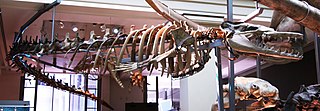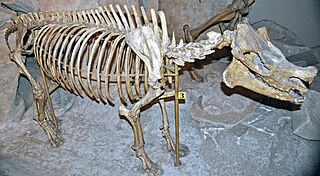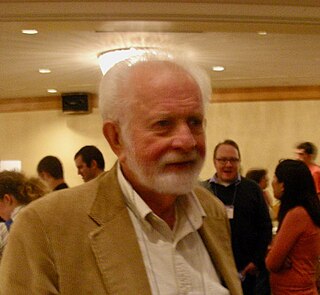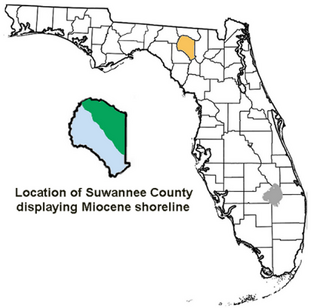
The Paleobiology Database (PBDB) is an online resource for information on the distribution and classification of fossil animals, plants, and microorganisms.

The Paleobiology Database (PBDB) is an online resource for information on the distribution and classification of fossil animals, plants, and microorganisms.
The Paleobiology Database originated in the NCEAS-funded Phanerozoic Marine Paleofaunal Database initiative, which operated from August 1998 through August 2000. From 2000 to 2015, PBDB received funding from the National Science Foundation. PBDB also received support form the Australian Research Council. From 2000 to 2010 it was housed at the National Center for Ecological Analysis and Synthesis, [1] a cross-disciplinary research center within the University of California, Santa Barbara. It is currently housed at University of Wisconsin-Madison and overseen by an international committee of major data contributors.
The Paleobiology Database works closely with the Neotoma Paleoecology Database, which has a similar intellectual history, but has focused on the Quaternary (with an emphasis on the late Pleistocene and Holocene) at timescales of decades to millennia. Together, Neotoma and the Paleobiology Database have helped launch the EarthLife Consortium, a non-profit umbrella organization to support the easy and free sharing of paleoecological and paleobiological data.
Partial list of contributing researchers: [2]
Donald Prothero has asserted that for several Cenozoic mammal families, range data in the PBDB are exaggerated due to uncritical inclusion of mistaken data. [3]

The National Museum of Natural History (NMNH) is a natural history museum administered by the Smithsonian Institution, located on the National Mall in Washington, D.C., United States. It has free admission and is open 364 days a year. With 4.4 million visitors in 2023, it was the third most-visited museum in the United States.

Basilosaurus is a genus of large, predatory, prehistoric archaeocete whale from the late Eocene, approximately 41.3 to 33.9 million years ago (mya). First described in 1834, it was the first archaeocete and prehistoric whale known to science. Fossils attributed to the type species B. cetoides were discovered in the United States. They were originally thought to be of a giant reptile, hence the suffix "-saurus", Ancient Greek for "lizard". The animal was later found to be an early marine mammal, prompting attempts at renaming the creature, which failed as the rules of zoological nomenclature dictate using the original name given. Fossils were later found of the second species, B. isis, in 1904 in Egypt, Western Sahara, Morocco, Jordan, Tunisia, and Pakistan. Fossils have also been unearthed in the southeastern United States and Peru.

Menoceras is a genus of extinct, small rhinocerotids endemic to most of southern North America and ranged as far south as Panama during the early Miocene epoch. It lived from around 30.7—19.7 Ma, existing for approximately 11 million years.

The Natural History Museum is a natural history museum located in Berlin, Germany. It exhibits a vast range of specimens from various segments of natural history and in such domain it is one of three major museums in Germany alongside Naturmuseum Senckenberg in Frankfurt and Museum Koenig in Bonn.

Paleobiology is an interdisciplinary field that combines the methods and findings found in both the earth sciences and the life sciences. Paleobiology is not to be confused with geobiology, which focuses more on the interactions between the biosphere and the physical Earth.

Charles Whitney Gilmore was an American paleontologist who gained renown in the early 20th century for his work on vertebrate fossils during his career at the United States National Museum. Gilmore named many dinosaurs in North America and Mongolia, including the Cretaceous sauropod Alamosaurus, Alectrosaurus, Archaeornithomimus, Bactrosaurus, Brachyceratops, Chirostenotes, Mongolosaurus, Parrosaurus, Pinacosaurus, Styracosaurus ovatus and Thescelosaurus.

Nothrotheriops is a genus of Pleistocene ground sloth found in North America, from what is now central Mexico to the southern United States. This genus of bear-sized xenarthran was related to the much larger, and far more famous Megatherium, although it has recently been placed in a different family, Nothrotheriidae. The best known species, N. shastensis, is also called the Shasta ground sloth.

William Alvin Clemens Jr. was a paleontologist at the University of California at Berkeley. He was faculty of the Department of Paleontology from 1967, then the Department of Integrative Biology from 1994 to his retirement and curator of the UC Museum of Paleontology. Clemens was also director of the museum (1987–1989) and chair of the Department of Paleontology (1987–1989). He was awarded a Guggenheim Fellowship (1974–75), a U.S. Senior Scientist Award by the Alexander von Humboldt Foundation, the Romer-Simpson Medal (2006), and was made a Fellow of the California Academy of Sciences.

Diceratherium is an extinct genus of rhinocerotid native to North America during the Oligocene through Miocene living from 33.9 to 11.6 mya, existing for approximately 22.3 million years. Mass estimates for the type species, D. armatum average around 1 t (2,200 lb)
Xiaoming Wang is a Chinese-born American vertebrate paleontologist and geologist who lives and teaches in the United States.

Hemiauchenia is a genus of laminoid camelids that evolved in North America in the Miocene period about 10 million years ago. This genus diversified and entered South America in the Late Pliocene about three to two million years ago, as part of the Great American Biotic Interchange. The genus became extinct at the end of the Pleistocene. The monophyly of the genus has been considered questionable, with phylogenetic analyses finding the genus to paraphyletic or polyphyletic, with some species suggested to be more closely related to living lamines than to other Hemiauchenia species.

The Cheadle Center for Biodiversity and Ecological Restoration (CCBER) is a research center under the Office of Research at the University of California, Santa Barbara (UCSB) whose mission is to preserve regional biodiversity and restore ecosystems on campus lands. CCBER has three main functions: curation and preservation of natural history collections, native coastal ecosystem and habitat restoration on campus lands, and education and outreach for both UCSB students and local community schools.

The Suwannee County, Florida paleontological sites are assemblages of Early Miocene invertebrates and vertebrates occurring in Suwannee County, Florida.
John Alroy is a paleobiologist born in New York in 1966 and now residing in Sydney, Australia.

Donald Ross Prothero is an American geologist, paleontologist, and author who specializes in mammalian paleontology and magnetostratigraphy, a technique to date rock layers of the Cenozoic era and its use to date the climate changes which occurred 30–40 million years ago. He is the author or editor of more than 30 books and over 300 scientific papers, including at least 5 geology textbooks.

A scientific collection is a collection of items that are preserved, catalogued, and managed for the purpose of scientific study.

A list of prehistoric and extinct species whose fossils have been found in the La Brea Tar Pits, located in present-day Hancock Park, a city park on the Miracle Mile section of the Mid-Wilshire district in Los Angeles, California.

The Ash Hollow Formation of the Ogallala Group is a geological formation found in Nebraska and South Dakota. It preserves fossils dating back to the Neogene period. It was named after Ash Hollow, Nebraska and can be seen in Ash Hollow State Historical Park. Ashfall Fossil Beds State Historical Park is within this formation.
The Dove Spring Formation is a geologic formation in the western Mojave Desert of California. It preserves fossils dating back to the Miocene epoch of the Neogene period.
The Neotoma Paleoecology Database (Neotoma) is an open international data resource that stores and shares multiple kinds of fossil, paleoecological, and paleoenvironmental data. Neotoma specializes in fossil data holdings at timescales covering the last several decades to the last several million years. Neotoma is organized and led by scientists and enhances data consistency through community curation by experts. Neotoma data are open to all and available to anyone with an internet connection.